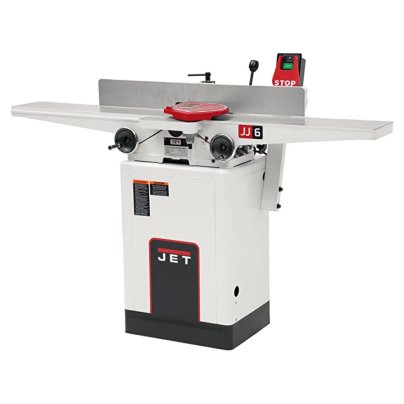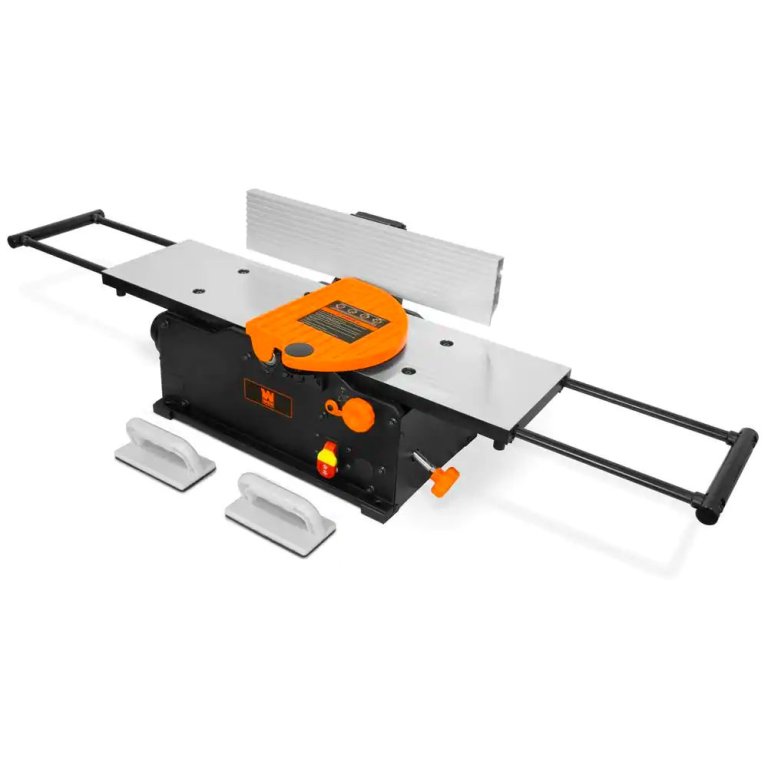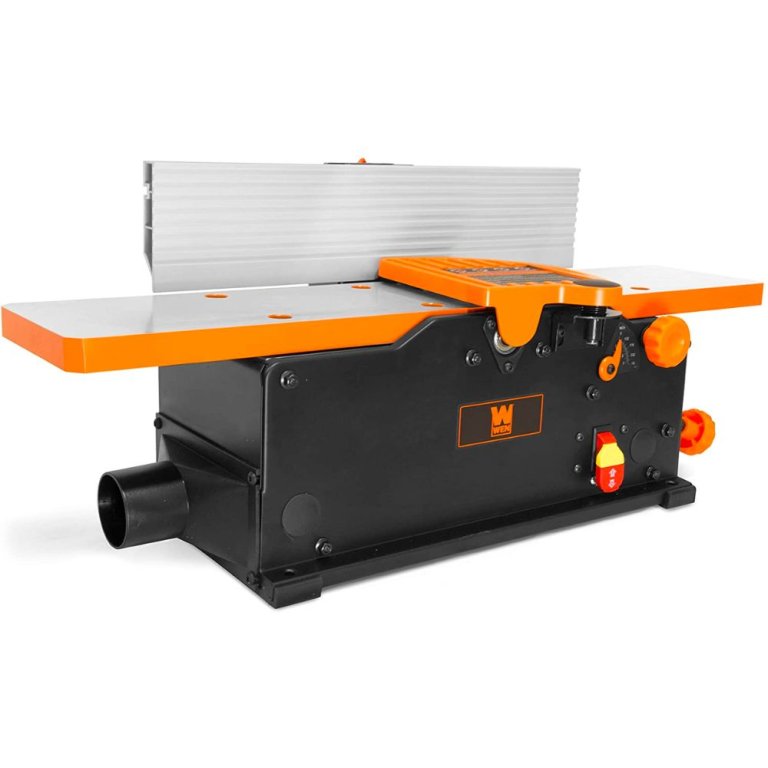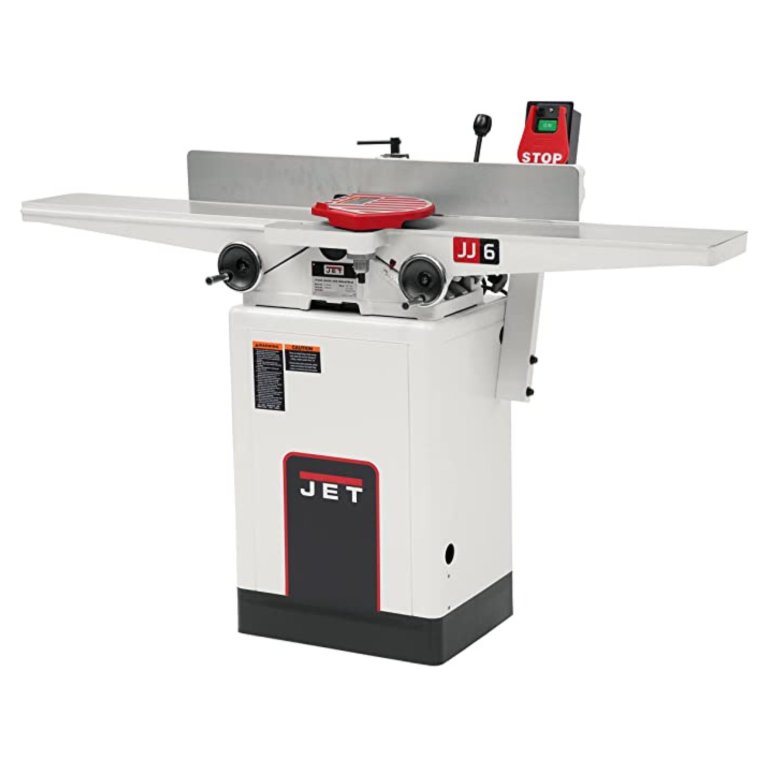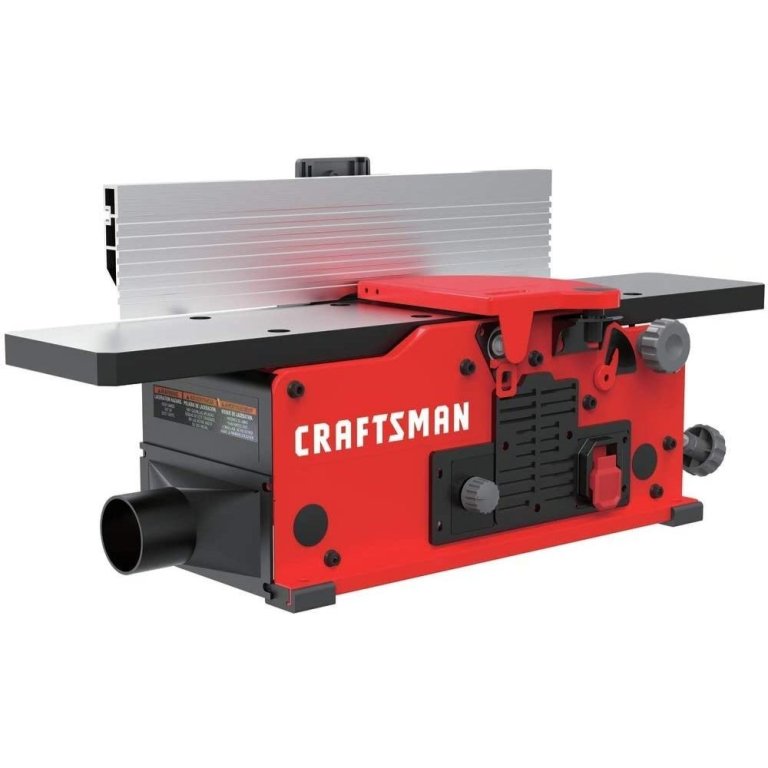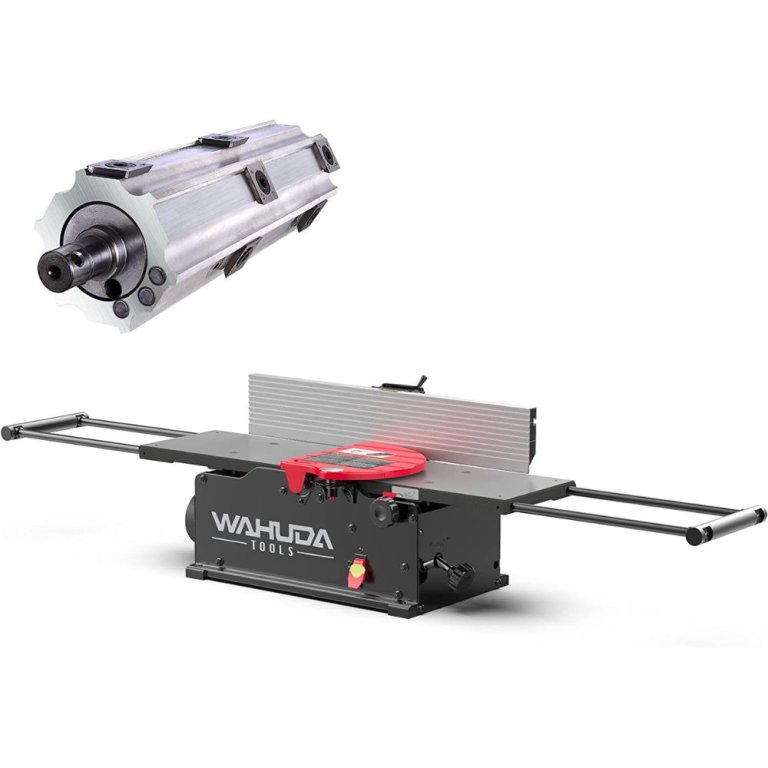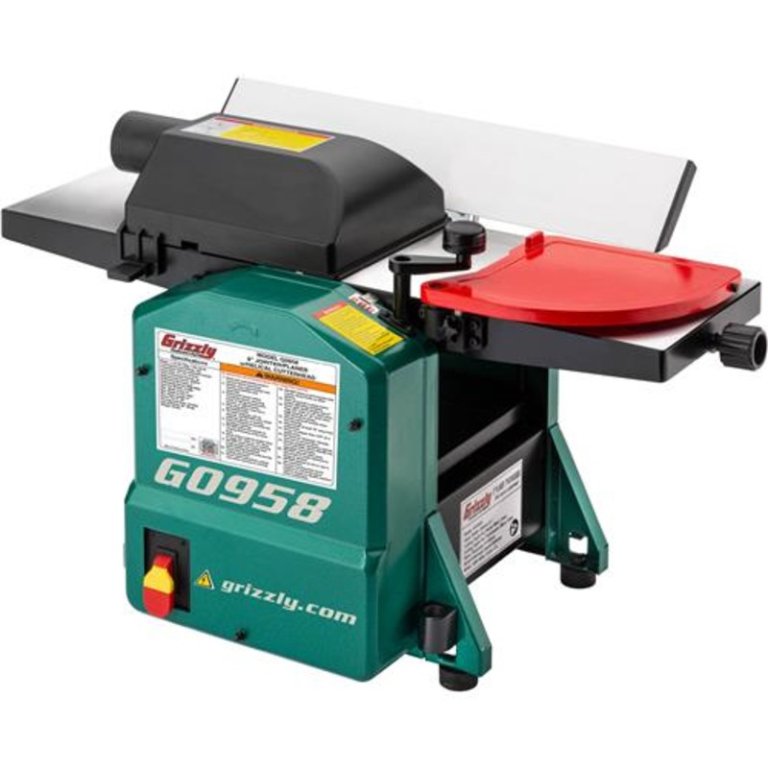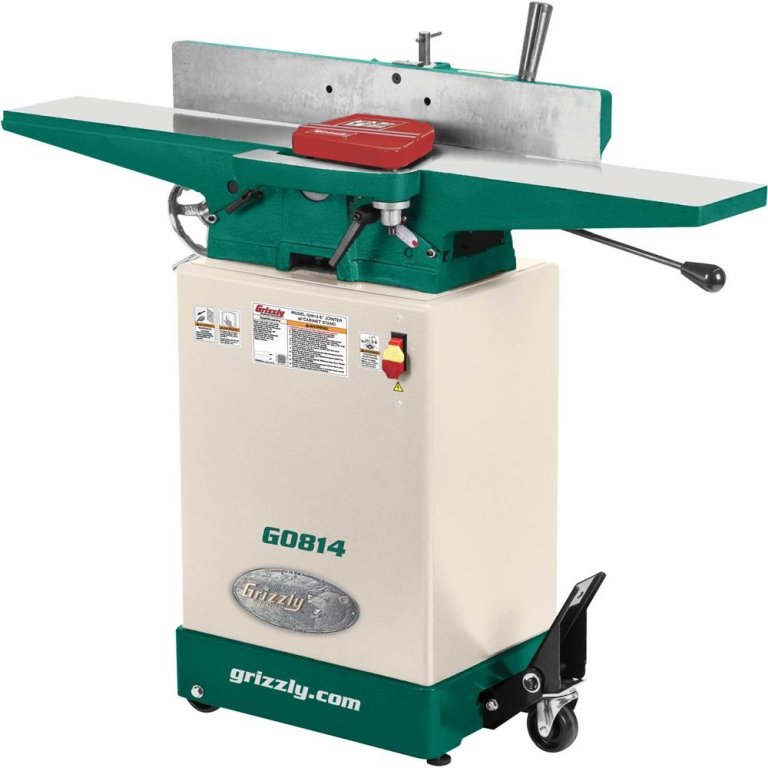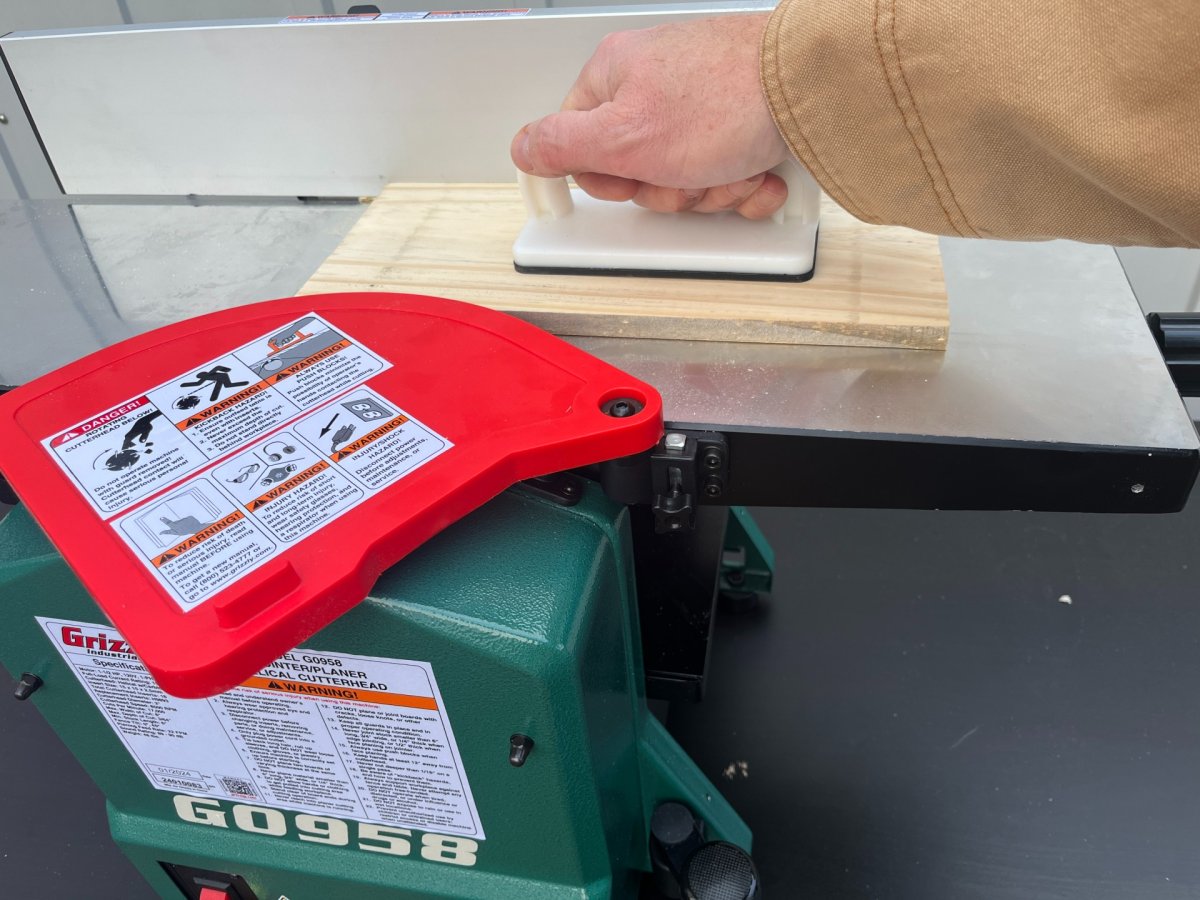
We may earn revenue from the products available on this page and participate in affiliate programs. Learn More ›
A jointer is a woodworking machine that smooths and flattens the faces and edges of stock lumber to make them perfectly square. These tools have a long, flat surface bisected by a cutting head with a cast iron guide fence. As woodworkers push the wood through, the blades on the cutting head shave off a thin surface layer to create a smooth, square edge.
Those who haven’t used a jointer before may not know which features matter most when selecting one. To help, we researched dozens of popular models and reached out to a woodworking expert for insight. Based on our efforts, we chose the Wen JT833H 10-Amp 8″ Spiral Benchtop Jointer as our top pick. It has a powerful motor, a versatile 8-inch capacity, a durable spiral cutterhead, and a spacious extendable table. If a cabinet-style model or a jointer-planer combo is what you’re after, one of our other favorites might be a better choice. Read on for detailed reviews and key shopping considerations to select one of the best jointers for your woodworking needs.
- BEST OVERALL: Wen JT833H 10-Amp 8″ Spiral Benchtop Jointer
↓ Jump to Review - BEST BANG FOR THE BUCK: Wen JT630H 10-Amp 6″ Spiral Benchtop Jointer
↓ Jump to Review - BEST CABINET-STYLE: Jet JJ-6HHDX 6″ Long Bed Helical Head Jointer
↓ Jump to Review - BEST VARIABLE SPEED: Craftsman CMEW020 10-Amp Benchtop Jointer
↓ Jump to Review - BEST 8-INCH: Wahuda 50180CC-WHD 8″ Benchtop Jointer
↓ Jump to Review - BEST JOINTER PLANER: Grizzly G0958 8″ Combo Planer/Jointer
↓ Jump to Review - ALSO CONSIDER: Grizzly Industrial G0814 Jointer With Cabinet Stand
↓ Jump to Review
Jointers Comparison
| Product Name | Blade Width | Maximum RPM | Table Length |
| Wen JT833H 10-Amp 8″ Spiral Benchtop Jointer | 8 inches | 11,000 | 33 to 51 inches |
| Wen JT630H 10-Amp 6″ Spiral Benchtop Jointer | 6 inches | 11,000 | 30 inches |
| Jet JJ-6HHDX 6″ Long Bed Helical Head Jointer | 6 inches | 6,000 | 56 inches |
| Craftsman CMEW020 10-Amp Benchtop Jointer | 6 inches | 11,000 | 30 inches |
| Wahuda 50180CC-WHD 8″ Benchtop Jointer | 8 inches | 12,000 | 34 to 51 inches |
| Grizzly G0958 8″ Combo Planer/Jointer | 8 inches | 8,500 | 29¼ inches |
| Grizzly Industrial G0814 Jointer With Cabinet Stand | 6 inches | 5,000 | 47⅜ inches |
Our Top Picks
The following list includes a variety of excellent jointers to suit virtually any need. Each jointer machine features a 6- or 8-inch cutterhead, a powerful motor, and durable construction. One will certainly be the right woodworking tool for your workshop.
Best Overall
Photo: The Home DepotWhat We Like
- Extendable table saves space and accommodates larger projects
- Spring-loaded blade guard provides added safety
- 2½-inch and 4-inch dust ports
- Great price for an 8-inch jointer
What We Don’t Like
- Motor isn’t as powerful as professional 8-inch models
- May require alignment during setup
Specs
- Blade width: 8 inches
- Maximum rpm: 11,000
- Table length: 33 to 51 inches
While 8-inch jointers are typically designed for professional shops and often cost thousands of dollars, Wen’s 8-inch woodworking jointer offers an excellent balance of affordability, power, and versatility, making it a great choice for serious DIY enthusiasts. Beyond its impressive size, it offers superior performance thanks to a spiral cutterhead with 16 staggered high-speed steel (HSS) blades for a smooth finish on both hard and soft woods. Plus we love that the 33-inch table extends up to 51 inches, accommodating larger boards than most jointers.
With a 10-amp motor, this Wen benchtop jointer provides much more power than a handheld jointer, yet it’s still relatively portable at 55 pounds. It has an adjustable fence, depth-of-cut scale, and both 2.5- and 4-inch dust ports. As with Wen’s 6-inch jointer (reviewed below), it features a spring-loaded blade guard and push blocks for safety. While users may need to spend a little time aligning this model once it’s delivered, its impressive performance and inclusion of features typically found only on more expensive units make it worth it.
Get the Wen 8-inch jointer at Amazon, Lowe’s, The Home Depot, Walmart, Northern Tool + Equipment, or Wen.
Best Bang For The Buck
Photo: AmazonWhat We Like
- Perfectly sized for small to medium wood pieces
- Powerful 10-amp motor
- Easy-to-grip knobs and blade guard
- Adjustable fence bevels up to 45 degrees
What We Don’t Like
- Not built for heavy-duty use
Specs
- Blade width: 6 inches
- Maximum rpm: 11,000
- Table length: 30 inches
Those new to jointing or who only need a tool for a few projects a year will find that the Wen 6-inch spiral benchtop jointer is an excellent entry-level option that won’t break the bank. Like our top pick, it’s powered by a 10-amp motor and features staggered HSS blades (12 instead of 16). It also has large, easy-to-grip knobs to allow for simple blade depth adjustment from 0 to ⅛ inch.
This jointer’s 30-inch table is long enough to provide a comfortable workspace for new woodworkers, and it’s easy to move at just under 37 pounds. The aluminum adjustable fence measures 19¾ inches long by 4¼ inches wide and can bevel up to 45 degrees for enhanced versatility. It also has a spring-loaded blade guard and two push blocks for safety, as well as a 2.5-inch dust port for effective dust collection.
Get the Wen 6-inch jointer at Amazon, Lowe’s, The Home Depot, or Wen.
Best Cabinet Style
Jet JJ-6HHDX 6" Long Bed Helical Head Jointer
Buy at Amazon Buy at The Home Depot Buy at Northern Tool+EquipmentWhat We Like
- Helical head jointer with 27 four-sided blade inserts
- Extra-long 56-inch cast iron table
- 4-inch dust port and push-button controls
- Front-mounted adjustment handwheels
What We Don’t Like
- Included stand for bench top jointer increases price
- Large unit isn’t very portable
Specs
- Blade width: 6 inches
- Maximum rpm: 6,000
- Table length: 56 inches
Cabinet-style jointers provide a higher level of performance and precision than their benchtop cousins, making them suitable for professional workshops and serious woodworkers. Looking a bit like a reference photo in a woodworking book, this cabinet jointer from Jet weighs 240 pounds and has a cast iron work surface that is 56 inches long atop a one-piece steel closed stand. It also features an impressive 27-knife helical cutter that removes wood evenly for an ultra-smooth finish and a 1 horsepower (hp) motor that runs at 6,000 revolutions per minute (RPM).
Another of the many things we like about this option is its two-way tilting fence with positive stops at 45 and 90 degrees. It also has large front-mounted wheels that make raising and lowering the feed table and cutterhead easy, as well as convenient push-button controls for quick starts and stops.
Get the Jet jointer at Amazon, The Home Depot, or Northern Tool + Equipment.
Best Variable Speed
Photo: AmazonWhat We Like
- Easily portable at just 35 pounds
- 30-inch table ideal for small to medium lumber
- Variable speed provides sufficient torque for most projects
What We Don’t Like
- Fence can sometimes be difficult to adjust
Specs
- Blade width: 6 inches
- Maximum rpm: 11,000
- Table length: 30 inches
There’s a lot to like about this variable Craftsman jointer, which features a 10-amp motor that operates between 6,000 and 11,000 RPM to make up to 22,000 cuts per minute. This versatile and affordable option has a two-knife cutterhead with jackscrew leveling systems for easy blade replacement and adjustment as well as a 4½-inch center-mounted aluminum fence that tilts up to 45 degrees to provide plenty of support for precise cuts.
Weighing a manageable 35 pounds, this benchtop jointer is highly portable yet still handles boards up to 6 inches wide. While its sturdy 30-inch aluminum work surface helps keep its weight down, it may not be as durable as heavier-duty options. Still, given its reliable performance, it offers excellent value for its price point and is an ideal option for beginners and those needing an occasional-use tool.
Get the Craftsman jointer at Amazon or Lowe’s.
Best 8-Inch
Photo: AmazonWhat We Like
- Helical blade creates smooth and precise cuts
- Table extends from 34 to 51 inches
- Light enough to be portable
- 8-inch blade is suitable for making large cuts
What We Don’t Like
- Can take a little effort to get alignment right
Specs
- Blade width: 8 inches
- Maximum rpm: 12,000
- Table length: 34 to 51 inches
The Wahuda 8-inch benchtop jointer is a compact powerhouse that offers impressive features for its size. Its 10-amp motor runs at 12,000 RPM and delivers smooth cuts on both hard and soft woods. It also has a helical cutterhead with 16 four-sided carbide inserts, providing better finish quality and quieter operation than comparable straight-knife models. Its 34-inch table can expand to 51 inches to support longer boards.
At 64 pounds, this Wahuda benchtop jointer is stable yet relatively portable. The fence tilts from 90 to 135 degrees for enhanced versatility, it has large knobs for easy adjustments, and it features a 2½-inch dust port with a 4-inch adaptor. One word of warning, however: Be patient during the initial setup, as aligning the tables can be a bit challenging. However, given this unit’s quality build and long list of user-friendly features, the Wahuda strikes an excellent balance of performance and affordability.
Get the Wahuda jointer at Amazon or Wahuda.
Best Jointer Planer
Photo: LowesWhat We Like
- Provides good cutting accuracy and clean finished surfaces
- Converting between functions is quick and easy
- Plenty of power to resist bogging
What We Don’t Like
- Consistent snipe at board ends in planing mode
Specs
- Blade width: 8 inches
- Maximum RPM: 8,500
- Table length: 29¼ inches
Grizzly’s shop tools have a reputation for rugged performance and value pricing, and the G0958 is no exception. It boasts a powerful 1.5 hp motor, an 8-inch blade, and an 18-insert helical cutterhead that turns at a rate of 8,500 RPM for a smooth finished surface with minimal chipout. The table and fence are made of sturdy yet lightweight die-cast aluminum, keeping the unit’s total weight to just 55 pounds, so it’s easy to move around the shop.
During our tests of this two-in-one unit using pine and oak planks, there was no appreciable difference in its ability to work soft versus hard wood. We tested both its jointing and planing performance and found that the planer left behind sniped ends (true for all the combo units we tested), though they were easy to remove with a final pass or two on the jointer. Converting between the two cutting modes took less than a minute, and we had no trouble squaring the fence to the table.
What our tester says: “Of all the combo jointers/planers I’ve tested, this Grizzly benchtop is still my favorite. It’s easy to assemble, works well on hard and soft woods, and has a powerful motor that keeps the feed rate constant.” —Mark Wolfe, Product Reviews tester and writer
Get the Grizzly jointer planer at Lowe’s, Tractor Supply Co., The Home Depot, or Grizzly Industries.
Also Consider
Photo: The Home DepotWhat We Like
- Durable iron and steel construction
- Powerful 1 hp motor for quick, smooth cuts
- Mobile base increases portability
What We Don’t Like
- Cabinet stand increases price
Specs
- Blade width: 6 inches
- Maximum rpm: 5,000
- Table length: 47⅜ inches
Featuring a 1 hp motor that generates 15,000 cuts per minute, this heavy-duty jointer offers professional-grade performance at a price that fits a DIY budget. Its three-knife cutterhead spins at 5,000 RPM for efficient material removal, and its center-mounted fence is fully adjustable from 45 to 135 degrees. With a maximum cutting width of 6 inches and a depth of ⅛ inch, it can handle most standard jointing needs.
Made from a single piece of forged steel, the table is more stable than lower-end benchtop models. Though it weighs 245 pounds, its hefty mobile base has locking wheels that allow easy positioning during use. Part of that weight also comes from its 47-inch table, which is made from precision-ground cast iron with dovetailed ways. The only thing we’d really change about this model is that it comes with straight knives. More serious hobbyists may want to consider upgrading to a helical cutterhead for improved finish quality.
Get the Grizzly Industrial jointer at The Home Depot or Grizzly.
Jump to Our Top Picks
How We Chose the Best Jointers
We focused on power, table length, blade size, build quality, and user-friendly features to curate our list of the best jointers. Since a strong motor is essential for smooth cuts, each jointer we chose reaches at least 5,000 revolutions per minute (RPM). In terms of table length and blade size, skilled craftsman Jonathan Warshaw, founder and owner of Simple Woodworker, explains that “A larger size accommodates wider boards, which is common in wood supply, thereby saving both material and time.” The blades on our recommended jointers are 6 or 8 inches, and table lengths range from 30 to 56 inches.
Beyond size and power, ease of use is also important. A good jointer should have an adjustable fence with large knobs to enable precision cuts. Warshaw also emphasizes that “dovetail-style jointers have a proven track record of reliability. It’s vital that the tables align on the same plane for consistent results.” Lastly, to ensure a jointer provides long-term quality performance, look for a model constructed with durable materials like steel and cast iron, as these won’t warp or bend.
What to Consider When Choosing a Jointer
Since a benchtop jointer is a power tool, selecting the right one is more complicated than choosing a hand planer or a hand jointer planer. You’ll want to evaluate factors like power, blade width, table length, and portability to ensure you choose the best jointer for your woodshop.
Type
Jointers are generally available in two types: larger cabinet-style units and smaller benchtop units.
Cabinet-style jointers are freestanding units that combine a dedicated platform and the tool itself. They are heavy and sturdy and deliver greater precision and detailing in their cuts while usually accommodating longer pieces of wood. However, they also take up a fair amount of floor space in the shop, so those with smaller spaces or who won’t use the jointer regularly may prefer the smaller option.
A benchtop jointer is a popular choice for home woodworkers who don’t need the industrial strength of the larger and more expensive cabinet-style jointers. Smaller and lighter, they lack the power of a cabinet-style jointer, but they offer easier portability and storage.
The best jointers also include sturdy, adjustable fences and metal guards that allow for precision cutting. Cabinet jointers typically have more substantial fences than those on benchtop jointers because cabinet jointers handle longer pieces of wood.
Power
Power determines how easily a jointer can cut through wood. A more powerful jointer generally leaves a smoother finish on the wood than a less powerful model. High-powered models also do a better job of cutting through hardwoods and handling broader cuts.
A 6-inch jointer typically has a 1 horsepower (hp) motor—sufficient to handle most softwoods, hardwoods, and even many exotic woods. Jointers with 8-inch blades require motors with 2 hp engines. High-end commercial-grade jointers with blades up to 16 inches wide feature motors with as much as 3 hp.
Material
Of course, build quality matters with the majority of power tools, and it may matter most in a jointer. These tools make wood stock perfectly smooth and square, which requires them to be built from quality material that won’t bend or sag. Look for jointers with sturdy cast-iron feeder tables and guide fences that will stand up to long-term use.
Blades and Cutting Depth
Cutting depth determines how many times the user will have to run the wood through the jointer to make the wood smooth and flat. Cutting blade widths vary from 6 inches wide to as much as 16 inches wide. The wider the blade, the wider the wood stock the jointer can cut.
Cutting heads feature multiple blades. Smaller benchtop jointers have two or three cutting blades, while larger cabinet-style jointers have as many as four. More blades generally result in smoother cuts.
Most benchtop jointers can cut to a maximum depth of ⅛ inch, while commercial jointers feature depths up to ½ inch. Greater depth requires fewer passes to flatten a warped or uneven board.
Portability
Cast iron construction makes many jointers heavy and difficult to transport to a job site. Once a cabinet-style jointer finds a home in the workshop, it won’t be easy to move unless it’s on wheels. These massive power tools weigh between 250 and 500 pounds.
A benchtop planer is the lightest type of jointer (other than a masonry jointer, a completely different tool), but even some of these can weigh upward of 60 pounds. Though they aren’t particularly light, benchtop jointers are often small enough to transport to a job site.
Knife Options
When shopping for jointers, you’ll notice that some models feature straight blades while others have helical or spiral cutterheads. Straight blades use two or more rows of blades that run straight across the cutting head. They create smooth cuts but tend to wear out quickly and require replacement or frequent sharpening.
Some cutterheads use a helical or spiral-shaped blade arrangement similar to the double helix of a DNA strand, which creates a smoother finish on the wood’s surface. With a spiral cutting head, each blade remains parallel to the axis of the cutting cylinder. With a helical cutterhead, each blade sits 14 degrees off the cylinder’s axis, which creates a very smooth finish.
Dust Collection
Because jointers remove significant amounts of wood to flatten and smooth boards, they produce an enormous amount of sawdust. A dust collection system will keep the workshop clean and the air breathable.
Look for power jointers with large ports for removing sawdust. Smaller benchtop jointers feature 2-inch dust collection ports, while large cabinet-style jointers include dust collection ports as large as 4 inches in diameter.
Additional Features
Power jointers are relatively safe power tools because the wood stock or a retractable guard covers the blades while they cut, and they also often come with additional safety features. These may include push handles for guiding wood through the blade without using bare hands and easy-to-access “off” switches that allow users to quickly shut off power when needed.
Some jointers offer additional features that make them easier to use, such as large knobs that allow for quick and easy adjustment of the feeder table height and the adjustable fence angle.
FAQs
If you’re still wondering, “What is a jointer?” or need to know how a jointer differs from a planer, the following answers to frequently asked questions can help.
Follow the directions below to properly operate a jointer:
1.Begin by using a shop square to make sure the joint between the outfeed table and the guide fence is exactly 90 degrees. The point of a jointer is to make a perfectly square edge. If this joint isn’t 90 degrees, that won’t be possible.
2.Adjust the depth dial to the desired setting.
3.Position the wood stock on the infeed table with the crown side up, then turn on the jointer. Make sure to cut the face first, followed by the edges.
4.Keeping the wood stock firmly against the fence, push the lumber through the cutter using push pads.
5.Next, cut the other face, followed by both edges.
6.If done correctly, the result should be a perfectly square piece of lumber with four smooth sides.
Although a jointer and planer both remove wood from the sides of wood stock, a jointer is designed to take bowed or uneven lumber and make it straight and square. A planer removes larger amounts of wood, taking a thick board and reducing it to the desired thickness. To use a thickness planer, one side of the board must already be flat.
Jointers are sometimes confused with joiners. If you’re looking for a tool specifically for joining boards edge to edge, consider a biscuit joiner, which is designed to make strong, precise joints.
Most woodworkers agree that both a jointer and a planer are essential when working with rough lumber. If you have a planer, you can use it to achieve a consistent thickness across a board and then rely on a hybrid table saw or circular saw to clean up the edges, but the process will be easier and more accurate with a jointer.
Joint the face before the edge when using a jointer. This will ensure a flat surface for a base to create a perpendicular jointed edge.
When using a jointer, use horizontal force to keep the wood firmly against the fence while applying light downward pressure to counteract the upward force of the knives. As the board crosses the cutterhead, shift most of the pressure toward the outfeed table to help maintain the newly cut surface.
If you want to sharpen jointer blades, use a simple jig to hold the two knife cutterheads in place and sharpen the blades without uninstalling them. While you can purchase such a jig, you can also create one using a small block of hardwood that fits in the gap between the table and the cutter plus a dowel that blocks the blade and prevents the cutter from turning. After creating or buying a blade jig for the jointer, sharpen the blades using the following steps:
– Cover the outfeed table’s edges with thick tape so they aren’t damaged during the sharpening process.
– Once you’ve locked the blade in place with the jig, move the cutting head into the proper depth for sharpening. Place a scrap piece of wood on the cutting table and lower the outfeed table until the blade just makes contact with the wood.
– Using a 600-grit diamond sharpening stone, begin sharpening the blade by placing the stone on the blade, then draw it back in the direction of the outfeed table.
– Continue until you have created a small bevel across the length of the blade. Use a magnifying glass to examine the blade.
– Switch to a 1200-grit stone and repeat the process above.
– Once the blade is sharp, remove the jig, rotate to the next blade, replace the jig, and repeat the process until you have sharpened all the blades.
Even the best jointers need maintenance. The basics of maintaining a jointer include:
– Regularly inspecting, sharpening, and replacing knives to maintain cutting quality
– Adjusting the infeed and outfeed tables to maintain alignment
– Cleaning the dust port
– Squaring the fence
– Checking for loose bolts or screws
– Lubricating moving parts


